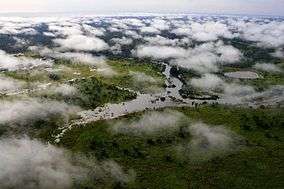Garamba National Park
| Garamba National Park | |
|---|---|
|
IUCN category II (national park) | |
|
An overhead view of the park | |
 | |
| Location | northeast section of the Democratic Republic of the Congo |
| Coordinates | 4°0′N 29°15′E / 4.000°N 29.250°ECoordinates: 4°0′N 29°15′E / 4.000°N 29.250°E |
| Area | 4,920 km² |
| Established | 1938 |
| Governing body | l'Institut Congolais pour la Conservation de la Nature (ICCN) |
| Type | Natural |
| Criteria | vii, x |
| Designated | 1980 (4th session) |
| Reference no. | 136 |
| State Party |
|
| Region | Africa |
| Endangered |
1984–1984; 1996–present |
Garamba National Park, located in Orientale Province of the Democratic Republic of the Congo in Africa, was established in 1938. One of Africa's oldest National parks, it was designated a UNESCO World Heritage Site in 1980. Garamba is (or at least was) the home to the world's last known wild population of Northern White Rhinoceros. Due to poaching of the rhinos within the park, it was added to the list of World Heritage in Danger in 1996. The park is also well known for its African elephant domestication programme started in the 1960s, which managed to train tourist-rideable animals.
History
The park was first placed on the List of World Heritage in Danger in the mid-1980s after the International Union for the Conservation of Nature and Natural Resources(IUCN) estimated that as few as 15 northern white rhinos remained. The World Wildlife Fund, Frankfurt Zoological Society and UNESCO/IUCN worked with the then Zairian government to rehabilitate the park. The effort paid off and the park was removed from the danger list in 1992 (Avant, 2004, 367). However, in 1991, a nearby town was captured by the Sudanese People's Liberation Army (SPLA) and refugees began to migrate into areas surrounding the park, growing to 50,000 by 1993. The inflow of refugees and members or former members of the SPLA also brought automatic weapons and military equipment into use in the taking of bushmeat from the animal populations within the park. The Garamba park guards were not capable of securing the park against the more heavily armed and trained poachers. There were 121 shoot-outs in the park between 1993 and 1995. African buffalo and elephants fell to the poachers. In 1996, two of the white rhinos were killed, leading to the return of Garamba to the World Heritage Site Danger List in that same year (Avant, 2004, 368).
The park's elephant population has fallen by 90%, from 20,000 in the 1960s to 2,000 in 2012.[1] In 2012, 22 elephants were killed in a helicopter attack by poachers who hacked off their tusks and genitals.[2] In 2014, poachers killed 68 elephants, including young ones without tusks, in two months from mid-April.[1]
Situation of the white rhino
It has been predicted that the northern white rhinos will soon be declared extinct due to high levels of poaching. As civil unrest hindered conservation efforts, plans were developed to transition the rhino to havens in Kenya but were not implemented — the Congolese argued that outsiders should not be allowed to take away their symbol. Only four individuals were recorded in an aerial survey of the park in 2005 but they are now presumed dead due to the civil unrest in the area.[3]
See also
- Centre National d’Appui au Développement et à la Participation populaire
- World Heritage Sites in Danger
References
- 1 2 Schemm, Paul (13 June 2014). "Poachers massacre elephants in Congo park". CTV News. The Associated Press.
- ↑ Tomilson, Simon. "Unimaginable horror as helicopter-borne poachers massacre 22 elephants before hacking off their tusks and genitals". Daily Mail.
- ↑ Smith, Lewis (17 June 2008). "Poachers kill last four Northern White Rhino". The Times. London.
- Avant, Deborah (2004). "Conserving nature in the state of nature : the politics of INGO policy implementation". Review of International Studies. 30 (03): 361–382. doi:10.1017/S0260210504006114.
- IUCN SSC African Rhino Specialist Group (2008). "Ceratotherium simum ssp. cottoni". IUCN Red List of Threatened Species. Version 2008. International Union for Conservation of Nature. Retrieved 2 July 2009.
